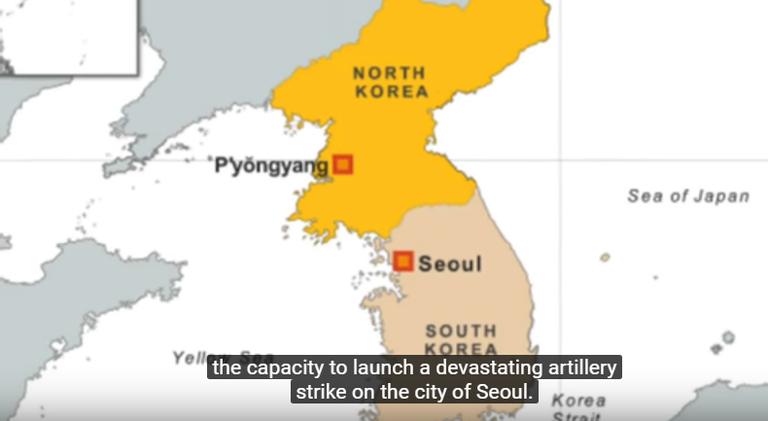 it reaches out to allies in confronting North Korea’s latest provocations.
it reaches out to allies in confronting North Korea’s latest provocations.
North Korea has been conducting missiles tests in open defiance of U.S and international community.
U.S has deployed massive firepower around North Korea, with more than one Carrier Strike Group stationed in Korean waters, but has till now refrained from taking any military action.
In this video, Defense Updates analyzes the scenarios, and reasons that is preventing Trump administration from using force.
So, lets get started.
ARTILLERY
A devastating attack on the city of Seoul.

The opponents' capitals are just 120 miles apart, with Seoul within 35 miles of the border.
Most of the North’s artillery pieces—numbering in the thousands—are already in place camouflaged and dug in.
North Korea’s artillery pieces include the 170 mm Koksan, which has a range of about 25 miles (40 km), using conventional projectiles.
However, the Seoul is well within range of the Korean People’s Army rocket-assisted shells—which have a range of around 40 miles (60 km), if the guns are stationed near the border region.
Being self-propelled, 170 mm Koksan can be easily moved close to the international border.
Even with massive preemptive strike, U.S and South Korean forces wont be able to neutralize them fully, a decent percentage of these will still remain working.
Covering only about 12% of the country's area, the Seoul Capital Area is home to more than 48.2% of the national population, and is the world's third largest urban area.
GROUND FORCES:
North Korea has more than 1.2 million active soldiers, and a further 7.7 million in reserve, making its ground force one of the largest in the world. Its troops are bolstered by 200,000 highly trained special ops soldiers.
These 200000-odd special operations forces are tasked to carry out attacks on major South Korean and American facilities in South Korea, as well as assassinations of government officials. The commandos would infiltrate the South by using underground tunnels, mini-subs and Russian Antonov An-2 biplanes during a war.
It must me noted that North Korean army is decently equipped.
The force consists of about 4,200 tanks and 2,200 armored vehicles.
South Korea has much smaller army of around 500,000 personnel and could be overwhelmed.
Again in this case, Seoul will be in the direct line of fire and huge fatality is expected.
MISSILE & NUKES:

The first nuke test was conducted by North Korea on Oct. 8, 2006. As per the United States analysts, it had a yield of less than 1 kiloton of TNT.
Blasts have become more powerful since then.
The device tested by the North, in January 2016, had a force equivalent of 7 kilotons of TNT.
By contrast, the device detonated on Sept 2016 looks to have had a force equivalent of 25 kilotons of TNT, according to the most analysis.
So it can be inferred that North Korea currently has a decent nuclear arsenal in its hand, and looking at increasing yield of its bombs, it can be said that it will have immense destructive power at its disposal in coming days.
North has a fairly significant ballistic missile capability. Some estimates show that North Korea has over 600 short-range Scud missiles, more than 200 Nodong missiles, and about 50 Musudan and Taepodong missiles.
Apart of from that, North is testing new intermediate range ballistic missiles.
These weapons could be used to deliver nukes to targets around the Korean peninsula and beyond.
As evident, it is making progress in enhancing missile range, and optimizing its atomic weapons.
Recently US has made Terminal High Altitude Area Defense (THAAD), operational in South Korea.
THAAD is an anti-ballistic missile system, which is designed to shoot down short, medium, and intermediate range ballistic missiles in their terminal phase.
US also has stationed Arleigh Burke class destroyers in Korean waters.
The Arleigh Burke class of guided missile destroyers (DDGs) is the United States Navy's first class of destroyer built around the Aegis Combat System.
The Aegis Ballistic Missile Defense System is a United States Department of Defense Missile Defense Agency program developed to provide missile defense against short to intermediate-range ballistic missiles. Aegis BMD is designed to intercept ballistic missiles post-boost phase and prior to reentry.
It enables Arleigh Burke class to shoot down enemy ballistic missiles by expanding the Aegis Combat System with the addition of the AN/SPY-1 radar and Standard missile technologies.
But both THAAD & Aegis BMD, have their share of hits and misses in test environment, it can be safely assumed that not all incoming missile will be intercepted.
Congratulations @denverdave! You have completed some achievement on Steemit and have been rewarded with new badge(s) :
Click on any badge to view your own Board of Honnor on SteemitBoard.
For more information about SteemitBoard, click here
If you no longer want to receive notifications, reply to this comment with the word
STOPBy upvoting this notification, you can help all Steemit users. Learn how here!